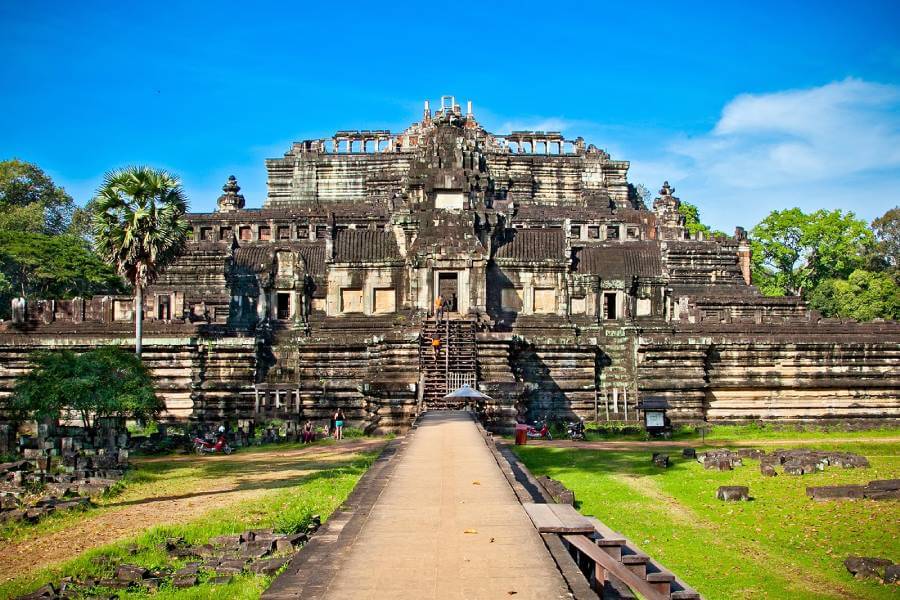Khmer stone sculptures are a testament to the ancient Khmer civilization, which thrived in what is now modern-day Cambodia and left behind a rich legacy of art and architecture. These sculptures, including those with lifelike human faces, are among the most impressive examples of their artistic achievements. Even today, these remarkable creations continue to fascinate and inspire people around the world. In this guide, we will explore the techniques and tools used by the ancient Khmer to create these impressive stone sculptures with human faces. From carving to polishing to capturing lifelike human expression, the ancient Khmer employed a variety of methods to create their works of art.
Contents
Carving Khmer Stone Sculptures
One of the most common techniques used by the ancient Khmer to create their stone sculptures was carving. They would start with a large block of stone and use chisels and hammers to carefully chip away at the stone until the desired shape was achieved. This process required a great deal of skill and patience, as it was a slow and meticulous process. The ancient Khmer artists would need to have a clear vision of the final product in their minds and carefully chip away at the stone.
The process of carving Khmer stone sculptures required different tools depending on the type of stone and the desired effect. For instance, tougher stones like granite necessitated the use of more forceful chisels and hammers, whereas softer stones like sandstone could be worked on using lighter tools. Despite the challenges involved in the carving process, the ancient Khmer craftsmen were able to create intricate and highly-detailed sculptures. Their artistic creations, from the delicate lines of a human face to the flowing robes of a deity, continue to impress and inspire us even to this day.
Polishing and Sanding Techniques
In addition to carving, the ancient Khmer also employed polishing and sanding techniques to refine their stone sculptures. After the initial carving was completed, the stone was smoothed and polished using abrasive materials such as sandstone and pumice. This process was done by hand and required a great deal of patience and attention to detail. The polishing and sanding process was important for achieving a smooth and polished finish on the stone, which was essential for bringing out the details of the sculpture. The ancient Khmer artists used progressively finer abrasives to achieve the desired finish, starting with coarse sandstone and moving on to finer grits of sandpaper or pumice.
Depicting Human Faces of Khmer Stone Sculptures
The human faces depicted in the ancient Khmer sculptures were often those of rulers or deities. The ancient Khmer were skilled at capturing the nuances of human expressions, such as wrinkles, frowns, and smiles, which made their sculptures incredibly realistic and lifelike.
The ancient Khmer artists achieved a remarkable level of realism in their Khmer stone sculptures by observing human facial features carefully. They would study the person's features they intended to depict, and use that knowledge to guide their carving. In addition, they employed a variety of facial expressions to create lifelike human faces in their Khmer stone sculptures. By skillfully manipulating the facial features, they could create a wide range of expressions, from calm and peaceful to fierce and menacing. The ancient Khmer were true masters of their craft, utilizing a range of techniques and tools to create breathtaking Khmer stone sculptures with lifelike human faces. Their artistic creations continue to inspire and captivate people all over the world to this day.
Famous Khmer Stone Sculptures
Bayon Temple
The ancient Khmer civilization left behind a wealth of stone sculptures, many of which have become famous around the world. One such example is the smiling face towers of the Bayon temple, located in the ancient city of Angkor Thom. These towers feature huge stone faces, each with a serene, enigmatic smile that has captured the imagination of visitors for centuries.
The Reclining Buddha statue
Another famous Khmer stone sculpture is the Reclining Buddha, located in the Silver Pagoda, a temple complex situated within the grounds of the Royal Palace in Phnom Penh, Cambodia. This statue is considered to be one of the most important cultural artifacts in the country, and it is renowned for its intricate design and religious significance. The Silver Pagoda itself is also a popular tourist attraction, with visitors from around the world coming to admire its stunning architecture and rich cultural heritage.
The Baphuon Temple
The Baphuon temple, also located in the ancient city of Angkor Thom, is home to another famous Khmer stone sculpture. The temple features a huge, reclining Shiva statue carved entirely from sandstone. The statue is over 27 meters long and features intricate details and lifelike features, including the folds of its robe and the expression on its face. These and many other examples of Khmer stone sculptures continue to be admired and studied today. Their intricate details, lifelike features, and stunning beauty are a testament to the skill and creativity of the ancient Khmer artists who created them.
The Khmer stone sculptures created by the ancient Khmer civilization are a testament to their artistic achievements and cultural legacy. Their ability to craft remarkable sculptures with human faces through skillful craftsmanship and creative thinking is awe-inspiring. These Khmer stone sculptures continue to captivate and inspire people all over the world today, preserving the ancient Khmer's artistic legacy for future generations to appreciate.
Their carving techniques, using chisels and hammers, were incredibly precise and required a great deal of skill and patience. Their polishing and sanding techniques allowed them to achieve a smooth and polished finish, bringing out the details of their sculptures. And their ability to capture the nuances of human expression in their depictions of human faces was truly remarkable. On a Cambodia tour, visitors can appreciate how the ancient Khmer artists were not only adept craftsmen but also possessed a creative and imaginative spirit. They brought their visionary ideas to life through the manipulation of stone, creating enduring works of art that are still widely admired and studied today.










